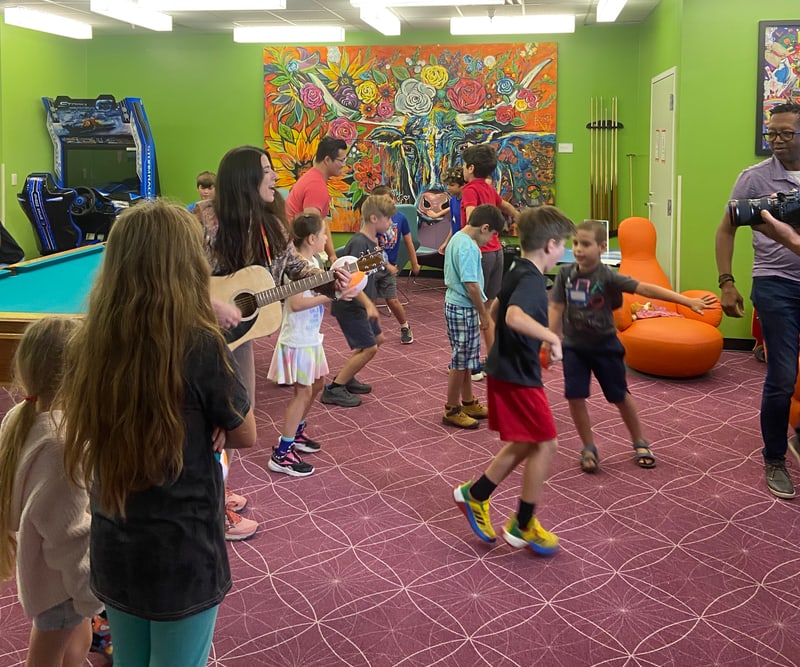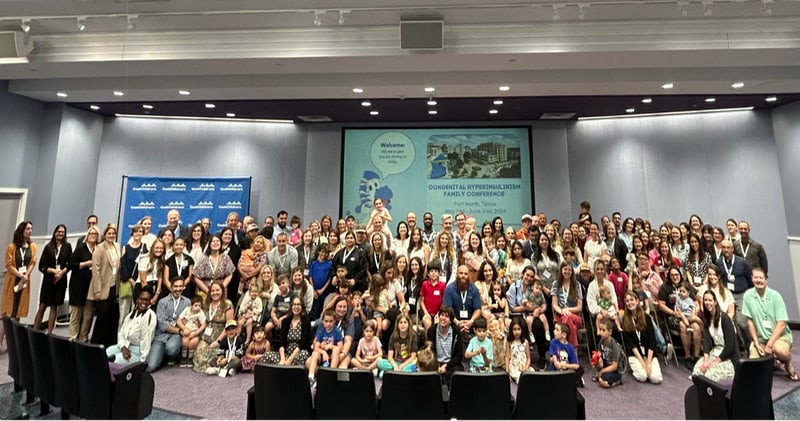As CHI’s Communications Associate, one of my primary roles is to elevate the patient voice in our hyperinsulinism advocacy work. Working digitally, though, can take me out of the real-life challenges that come along with HI management – I don’t see first-hand the daily inconveniences and anxieties around food, development, and mobility. At our most recent Family Conference with Cook Children’s in Fort Worth, Texas – my first Family Conference! – one mom’s presentation of her HI-story put this into perspective. She shared that her son’s G-tube (gastronomy tube) had stopped working while moving into their new house – she described it as being like Murphy’s Law, adding that “whatever can go wrong with HI management will go wrong, and at the most inconvenient times.” And while thankfully nothing quite that extreme happened during my time at Cook Children’s fabulous Child Life Zone (CLZ), my Saturday with 30+ HI kids proved her theory to be correct.
The CLZ gave us access to a recording studio, a drum circle, air hockey, and a seemingly unlimited supply of crafts and activities to help facilitate meaningful relationships with one another. But it was the recording studio that really captured awe in all of the kids. The kids were thrilled to learn that we would be professionally recording them singing along to Janna Pelle’s “Down and Up” and even making a music video. Cheers came from the room, shouting “I’m going to be famous!,” “We’ll be on YouTube!” Janna, myself, and other volunteer babysitters from Cook Children’s staff helped teach the group the lyrics and hand motions to rehearse for the real deal; soon enough, they could do it all on their own, and we were ready for action. Forming a semi-circle around several microphones hanging from the ceiling, our eager stars began to sing along to Janna’s song, when suddenly a “briiiing, briiiiing” chimed from one child’s cellphone. Soon after restarting our performance, there came another, and another, leading one volunteer to ask, “can they silence their phones?” The alerts came, of course, from their Continuous Glucose Monitors (CGMs), leading several kids to leave the recording area and manage their sugar lows or spikes with the upmost responsibility that a seven-year-old should never need to have.

As the HI mom had lovingly put it earlier, our experiences with Murphy’s Law didn’t end there. The music video component of the day required a dance scene in the CLZ’s expansive, brightly colored game room. Some kids chose to jump around with their newfound friends, others danced holding hands with our fantastic volunteer babysitters. Soon, a breakdancing circle began to form – hardly fitting for our guitar sing-along song, but somehow perfect for the chaotic fun of the day. As more and more kids wanted to give their shot at breakdancing, one boy came up to me shyly and said, “I want to breakdance, but I have my backpack on. My G-tube’s there.” His G-tube, or gastronomy tube, is a tool that delivers continuous supplemental feeding or medicine. For HI kids, G-tubes often supply dextrose (sugar water). This boy’s backpack is a popular choice to conveniently bring his G-tube along with him. However, “convenience” can only go so far; like so many kids his age, he wanted to jump around and, of course, try breakdancing, which would have risked pulling his G-tube out. Sadly, his backpack did not afford him the same freedom of movement as the others had. He and I danced in our own little corner, until his friends eventually found new dance moves that he could join in on.

Truthfully, this moment broke my heart; not being familiar with the everyday struggles of HI management, it struck me just how much HI can interfere with what I know as a “typical,” carefree childhood. HI symptoms and management challenges pay no mind to occur at “convenient” times – hyperinsulinism shows itself on its own schedule. Even though these incidents – of not being able to breakdance, or sugar highs interrupting a performance – may seem inconsequential, they are simultaneously so meaningful. Acceptance and inclusion are essential to create uplifting friendships. And being with this many HI kids, all of whom have had to make countless accommodations within their young lives, it was beautiful to see a room full of people just “get it” and know exactly how to respond. They didn’t think twice before going right back into carefree play-mode. Witnessing these thoughtful accommodations the kids made for each other – like stepping away with a friend to drink some water, or trying out new, inclusive dance moves – really emphasized how important HI Family Conferences are. Even though Murphy’s Law tells us that what can go wrong will go wrong, when we are equipped with the right management tools, treatments, and a robust support system of friends who understand us, those “wrongs” can be managed, and children with HI can thrive.


